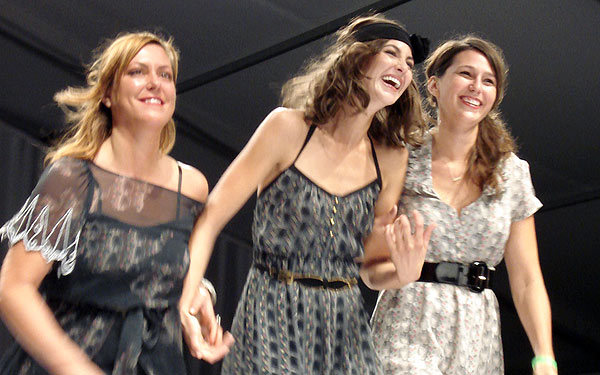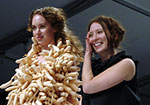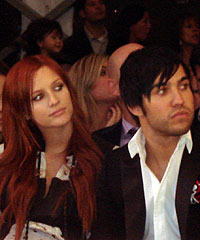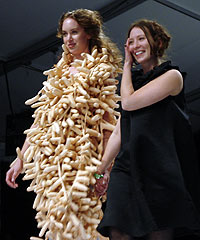
A model is flanked by the Eskell girls, aka Kelly Whitesell, left, and Elizabeth Del Castillo
|
|
This is not a fashion show review. Chicago just isn’t there yet. The New York Times’ Cathy Horyn may shoot down Givenchy, but that’s an established design house parading its collection in Paris. When it comes to Chicago—and here I’ll borrow a phrase from Coco Chanel—it doesn’t make sense to beat on a wall hoping it will turn into a door.
My point: Fashion in Chicago can be interesting, but for the audience, I think it’s still more about the novelty of an actual runway show than the quality of what you see on it. If you’re in the front row, sometimes you still have to hold your snicker. Occasionally, thankfully, our curiosity and hometown enthusiasm is occasionally rewarded with a flash of design brilliance. But make no mistake: Fashion here is still a fledgling enterprise.
GenArt‘s Fresh Faces in Fashion show is the best intersection of what Chicago aspires to be, fashionwise, and where we actually are as a city. Hosted by Pete Wentz last night in a big white tent in Millennium Park, the show kicks off a week of events that introduce the public to local designers and local designers to one another. The tent was standing-room-only full despite the $60 price of admission. But note to readers: Most of the events are free. For a full list, go here.
GenArt doesn’t showcase repeat designers from year to year; as the name Fresh Faces implies, these are the new guys. But it can be a little confusing, though, as the last designers to walk last night were the girls of Eskell, who’ve run a snazzy boutique here since 2005 and over time filled it, in part, with their own vintage-inspired designs.
I went in thinking that Eskell would be the highlight. And I liked their whole early 1980s sexy-mom-in-the-carpool vibe. They were all about the short sets and bringing back the dusty light blue denim wrap skirt that looked vaguely familiar (could it be my mom in her Jane Fonda stage, circa 1982?). I liked their palette of dusty blue, orange, and bright green, but a few times they brought out this zany hieroglyphic print. It looked bold on a runway, but on a real gal, pure schizophrenia.
|
|
Eskell’s collection held my interest, but the most professional assembly came from Anne Marie Novotny, a "sustainable" garment designer whose label is Frei Designs. She created the biggest hit—an ensemble of wide legged pants made out of a breathable bamboo fabric; a sheer striped vest; and a silvery sparkle tunic. She also produced the biggest head-scratcher—I’ll call it the "udder"—a little peach tube that she strung together as a necklace for early in the show. Her finale was a sewn tunic of these tubes—999 of them, the runway inventory says—which I heard alternately described as looking like fingers, Jell-O pops, and, har de har, the male appendage.
We’ve all seen Project Runway. We all remember the dress made out of human hair. Fashion people like to push the limits. That bothers me less than some of the other oversights from last night. Not enough Chicago designers think in terms of collections. They sent whatever they like parading down the runway without thought as to consistency of color or style. If we’re going to do this fashion thing, hey, let’s take a cue from TV. Let’s teach designers how to build collections. Let’s teach them respect for craftsmanship. (Last night there were seams, wrinkled fabrics, loose strings.) The one thing we do have is an enthusiastic audience. Now that’s something to build upon.
Photography: Carmen Rivera






 Anne Marie Novotny, right, with one of her models
Anne Marie Novotny, right, with one of her models